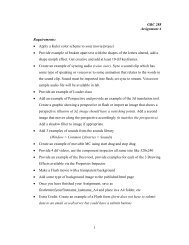Introducing Financial Accounting - CCSN Computer Graphics Program
Introducing Financial Accounting - CCSN Computer Graphics Program
Introducing Financial Accounting - CCSN Computer Graphics Program
Create successful ePaper yourself
Turn your PDF publications into a flip-book with our unique Google optimized e-Paper software.
wiL27041_ch01_002-047.indd Page 43 10/4/10 7:13:04 PM user-f499 /Volumes/204/MHBR211/wiL27041_disk1of1/0073527041/wiL27041_pagefiles<br />
Chapter 1 <strong>Introducing</strong> <strong>Financial</strong> <strong>Accounting</strong> 43<br />
2. Show the effects of the transactions on the accounts of the accounting equation by recording increases<br />
and decreases in the appropriate columns. Do not determine new account balances after each transaction.<br />
Determine the final total for each account and verify that the equation is in balance.<br />
3. Prepare a June income statement, a June statement of retained earnings, a June 30 balance sheet, and<br />
a June statement of cash flows.<br />
Swender Excavating Co., owned by Patrick Swender, began operations in July and completed these transactions<br />
during that first month of operations.<br />
July 1 P. Swender invested $60,000 cash in the company in exchange for common stock.<br />
2 The company rented office space and paid $500 cash for the July rent.<br />
3 The company purchased excavating equipment for $4,000 by paying $800 cash and agreeing to<br />
pay the $3,200 balance in 30 days.<br />
6 The company purchased office supplies for $500 cash.<br />
8 The company completed work for a customer and immediately collected $2,200 cash for the work.<br />
10 The company purchased $3,800 of office equipment on credit.<br />
15 The company completed work for a customer on credit in the amount of $2,400.<br />
17 The company purchased $1,920 of office supplies on credit.<br />
23 The company paid $3,800 cash for the office equipment purchased on July 10.<br />
25 The company billed a customer $5,000 for work completed; the balance is due in 30 days.<br />
28 The company received $2,400 cash for the work completed on July 15.<br />
30 The company paid an assistant’s salary of $1,260 cash for this month.<br />
31 The company paid $260 cash for this month’s utility bill.<br />
31 The company paid $1,200 cash for dividends.<br />
Required<br />
1. Arrange the following asset, liability, and equity titles in a table like Exhibit 1.9: Cash; Accounts Receivable;<br />
Office Supplies; Office Equipment; Excavating Equipment; Accounts Payable; Common<br />
Stock; Dividends; Revenues; and Expenses.<br />
2. Use additions and subtractions to show the effects of each transaction on the accounts in the accounting<br />
equation. Show new balances after each transaction.<br />
3. Use the increases and decreases in the columns of the table from part 2 to prepare an income statement,<br />
a statement of retained earnings, and a statement of cash flows—each of these for the current<br />
month. Also prepare a balance sheet as of the end of the month.<br />
Analysis Component<br />
4. Assume that the $4,000 purchase of excavating equipment on July 3 was financed from an owner investment<br />
of another $4,000 cash in the business in exchange for more common stock (instead of the<br />
purchase conditions described in the transaction). Explain the effect of this change on total assets, total<br />
liabilities, and total equity.<br />
Aspen Company manufactures, markets, and sells ATV and snowmobile equipment and accessories. The<br />
average total assets for Aspen is $2,000,000. In its most recent year, Aspen reported net income of<br />
$100,000 on revenues of $1,200,000.<br />
Required<br />
1. What is Aspen Company’s return on assets?<br />
2. Does return on assets seem satisfactory for Aspen given that its competitors average a 9.5% return on<br />
assets?<br />
3. What are the total expenses for Aspen Company in its most recent year?<br />
4. What is the average total amount of liabilities plus equity for Aspen Company?<br />
AT&T and Verizon produce and market telecommunications products and are competitors. Key financial<br />
figures (in $ millions) for these businesses over the past year follow.<br />
Key Figures ($ millions) AT&T Verizon<br />
Sales . . . . . . . . . . . . . . . . . . . . . . . . . $123,018 $107,808<br />
Net income . . . . . . . . . . . . . . . . . . . 12,535 10,358<br />
Average assets . . . . . . . . . . . . . . . . . 266,999 214,937<br />
Check (2) Ending balances: Cash,<br />
$118,080; Expenses, $8,070<br />
(3) Net income, $3,305;<br />
Total assets, $121,305<br />
Problem 1-9B<br />
Analyzing transactions and<br />
preparing financial statements<br />
C4 P1 P2<br />
Check (2) Ending balances: Cash,<br />
$56,280; Accounts Payable, $5,120<br />
(3) Net income, $7,580;<br />
Total assets, $71,500<br />
Problem 1-10B<br />
Determining expenses,<br />
liabilities, equity, and return<br />
on assets<br />
A1 A2<br />
Check (3) $1,100,000<br />
(4) $2,000,000<br />
Problem 1-11B<br />
Computing and interpreting<br />
return on assets<br />
A2









